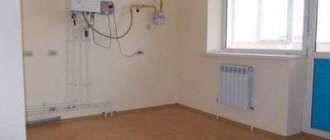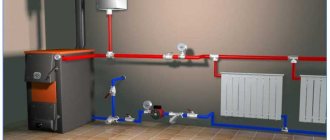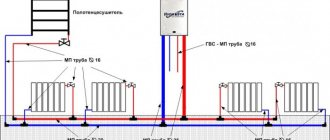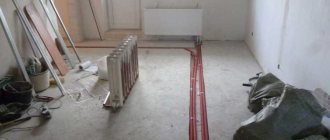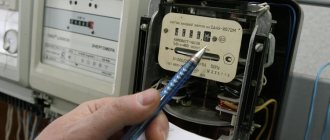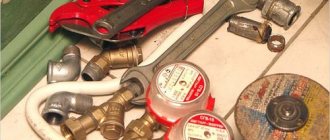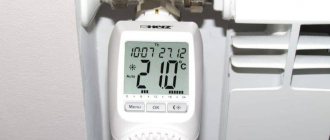Now no one needs to be convinced that a heat meter installed at the entrance to an apartment building can reduce heating costs (by an average of 30%). But residents often have another question: is it profitable to install an individual heat energy meter in an apartment or not? And if so, how to properly install it on central heating pipelines? The problem has two sides - formal and technical, and it is not easy for an ordinary citizen to understand the first.
Is it possible to install a heat meter in an apartment?
The answer is clear - yes, it is possible. Not a single legislative act in Russia, Ukraine or Belarus prohibits the installation of residential heat meters. Another thing is how the heat supplier company will react to your actions. Unauthorized intervention in the centralized heat supply system for the purpose of installing an apartment metering device is not allowed. For this you will receive a fine and waste money on equipment, since it will not be accepted for use.
It is noticeable in the photo that the installation of the meter was not only unauthorized, but also illiterate
Before installing an individual heat meter in an apartment with central heating, it is necessary to resolve the formal side of the issue by contacting the heat supply organization with a corresponding application. The further procedure in the countries of the former USSR looks almost the same:
- Based on your application, the company’s specialists check whether the installation of a metering unit is possible from a technical point of view. In case of a positive decision, the organization issues a defining document - technical specifications (common abbreviation - TU).
- If your apartment building is managed by an association of co-owners (housing association), then a copy of the application must be provided to the person appointed by the meeting and the installation of the heat meter must be agreed upon with him.
- With technical specifications, you must contact a design organization that has all the permits to carry out such work. For a fee, the company will make calculations and develop an installation project, certifying it with a seal.
- The project documentation must be agreed upon with the heat energy supply company, and then again contact a licensed installation company that professionally installs heat meters for heating.
- Put the metering unit into operation by the heat supply organization, draw up an agreement and pay for the supply of thermal energy upon delivery.
Procedure for installing an apartment heat meter
Advice. To speed up the procedure, it is better to contact an office that simultaneously deals with design, installation and approval for your money. Often, the entire range of services is provided by the heat supplier itself or indicates a certain private company that has a “friendly” mutually beneficial relationship with it.
The key is to review your application and obtain specifications. Here you need to take into account the requirements of legislative acts adopted in your country of residence. Let's look at them briefly.
Heat meters in the legislation of the Russian Federation
In the Russian Federation, Law No. 261 is in force, obliging the installation of communal heat metering devices at the expense of residents' associations (housing associations). The methodology for calculating payment for services in the presence of apartment and communal meters is regulated by Cabinet of Ministers Resolution No. 354. We will not delve into the legal jungle, but will present the requirements of legislative acts in accessible language in the form of theses:
- if there is no device at the entrance to an apartment building, payment for heat supply is calculated at tariffs with an increasing coefficient (in 2021 it is equal to 1.5);
- the laws of the Russian Federation do not oblige the owner of the apartment to install an individual heat meter, but they also do not prohibit doing so;
- the readings of your household appliance are taken into account only if 100% of other apartments and heated common areas are equipped with the same heat meters, and there is a common building metering unit at the input;
- The apartment heat meter is commissioned by the energy supply company and serviced by its specialists, but at the expense of the owner.
Note. Here are the requirements of regulatory documents in force as of 01/01/2017. The legislation is planned to be improved in the future, so those interested should monitor the changes.
From the above the following conclusions follow:
- A heat metering unit must be installed at home, otherwise the cost of the service increases by one and a half times, and the readings of the apartment heat meter are not taken into account.
- There is no point in spending money and time on installing an individual device if the heat consumption in the remaining rooms of the apartment building is not controlled. According to the law, the service provider organization can authorize the installation of a meter and issue technical specifications, but when calculating the payment for heat, it has the right not to take its readings into account.
There are situations when it is not technically possible to install a common building control unit, which is confirmed by an official act. In this situation, heat meters in the apartment or in the entrances are the only possible and correct option.
For reference. An individual device does not take into account the heat consumption spent on heating non-residential common areas (staircases, technical rooms in basements, and so on). Payment for these energy costs is distributed evenly among the co-owners of the apartment building.
From 2021, the readings of any apartment meters are taken into account - update
On December 28, 2021, a new Decree No. 1708 was issued in Russia. The legislative act contains changes to the current Rules for the provision of heating services to residents of apartment buildings. Let us briefly outline the essence of the innovations:
- The heat meter can be installed on any heating system - horizontal or vertical riser.
- With two-pipe horizontal wiring, the device is installed at the entrance to the apartment. In systems with vertical risers, a separate heat meter (otherwise known as a distributor) is mounted on each radiator.
- The management company is obliged to accept heat meters installed in accordance with the Rules into operation and take their readings into account when calculating payments for heating.
- The norm requiring the installation of such devices in 100% of the premises of an apartment building has been canceled.
- Payment is calculated in accordance with the current Resolution No. 354. The consumer pays for the consumed thermal energy (according to the meter) plus a share for heating common areas.
- The changes come into effect on January 1, 2021.
Required condition. At the entrance of the heating network to the building there should be a common house heat meter. Otherwise, it is useless to install individual meters - their readings will not be taken into account.
Features of heat metering in Ukraine
The legislation of this country also requires the widespread installation of heat meters in homes, only at the expense of energy supply companies. But, since the mechanism has not been fully developed, and clear implementation dates have not been established, many heat supply companies are delaying the implementation of such measures.
Reference. The relationship between consumers and suppliers in Ukraine is regulated by the “Rules for the Use of Thermal Energy”, born back in 2007 and approved by the relevant Cabinet of Ministers Resolution (No. 1198).
As for residential heat meters, they can be installed in accordance with the procedure given above. Legislative acts do not prohibit such actions (except for unauthorized ones) and do not establish strict conditions for heat metering in all rooms of the building. Although in practice, when preparing documentation, you may encounter different requirements of heat supply companies, sometimes illegal.
Important point. In order to install a heat meter in an apartment in Ukraine and successfully put it into operation, installation of a common building metering unit at the input is not necessary.
Technical side of the issue
A company providing central heating services may refuse to issue specifications if the apartment has an old one-pipe (two-pipe) system with vertical risers located in different rooms. Everything is simple here: to install a heat meter, you will have to power all the apartment radiators from one riser, which will lead to a change in coolant flow and imbalance of the system, and this is unacceptable.
In older central heating systems, it is much more difficult to organize individual heat consumption metering
It would seem that the way out is to install a heat meter on each radiator connected to a separate riser. But there are several nuances here:
- this is unprofitable for the apartment owner due to the price of equipment, installation work and subsequent maintenance;
- when sensors and flow meters are hung on the connections to the batteries, you will have to forget about the aesthetics of the interior;
- The energy supplier has the right to impose an additional payment for unaccounted heat released into the premises by vertical steel pipes or to require their insulation.
Judge for yourself: a riser with a diameter of 25 mm and a height of 2.7 m has a heat transfer area of 0.025 x 3.14 x 2.7 = 0.2 m². Two or three such pipes already transfer a significant amount of heat to the rooms. These values should be taken into account by engineers developing a project for installing metering devices. You will learn more information about installing heat meters for various central heating schemes from the video:
Advice. For residents of Ukraine, there is a proven way to organize local control of consumption in old heating systems - install a single metering unit at the entrance, placing it in a heating station, in the basement of the house. There, the risers are combined into a collector that cuts into the heating mains.
Heat meter on the connection to the radiator (left) and access heat meter in the basement (right)
Heat meter installation procedure
Before installing a heat meter in an apartment with central heating, you must follow a certain procedure:
- Submit a written application to the management company or HOA to obtain permission to install a heat meter. The following documents must be attached to the letter:
- copies of title documents for residential space;
- registration certificate of the apartment.
- Provide technical conditions for installation of the device from the heat energy supplier.
- Develop a project for individual heat metering and installation technical documentation - these actions must be performed by a company with the right to provide design services.
- Coordinate the design documentation with the heat supply company.
- Before buying and installing a heat meter in an apartment, it is better to go through full approval, as refusal is possible for a number of reasons. After agreement, you can begin to select a counter.
Residents of apartment buildings often wonder how to properly install such devices on central heating pipes. There is no prohibition in the law, but the management company may not like your desire.
In addition, there are regulations that do not allow interference with the central heating network . An unauthorized meter installed will not be accepted into operation. In this case, the owner of the apartment will also have to pay a hefty fine.
You will need to go through the entire cycle of indicated actions and receive an agreement under which you will pay for the heat you consume.
If you want to speed up the process of legalizing a heat meter, it is better to immediately contact a company that provides a full range of services: design, approval, installation. True, you will have to spend money.
Is it profitable to install individual heat meters?
After you go through all the vicissitudes of paperwork, installation of a heat meter and its commissioning, you will receive the following benefits:
- payment for the heat used specifically by you, and not some average costs throughout the building;
- it will be possible to save thermal energy when it is not required;
- By investing money in insulating the walls of your apartment, you will not only protect your home from the cold, but you will also pay less for heating in fact.
The payback of the project depends on many factors, ranging from how much the heating meter and installation services cost. Practice shows that payment for the device is reduced by an average of 25-30% compared to the tariffs applied in the absence of heat meters.
Advice. There is a simple way to verify the benefits of organizing individual heat energy metering. Analyze how much you paid for centralized heating 2-5 years ago and track the trend in tariff growth. Note that rising energy prices will not stop in the future.
Such a thermal head allows you not only to regulate the temperature, but also to change it according to the time of day.
Controlling the actual heat consumption is the first step to saving it. The second is the installation of valves with thermal heads on batteries that limit the heating of air in rooms, which is described in detail in this article. If you buy programmable thermal heads, then during your absence the temperature in the rooms can be reduced by 3-4 °C. The third step is thermal insulation of walls and ceilings with floors (if necessary).
Recommendations for choosing a device and its installation
To correctly account for the low flow rate of coolant used to heat an apartment, 2 types of household heat meters are used:
- mechanical (otherwise known as tachometer);
- ultrasonic.
Note. The technical parameters of commercial metering devices are determined by design engineers based on calculations.
This is what tachometer heat metering devices look like.
To understand the difference between them and make the right choice, you need to understand a little how a heat meter works. It consists of three main elements that perform their functions:
- A flow meter whose task is to determine the amount of water flowing through a pipe section per unit of time. It crashes into the supply pipeline.
- Forward and reverse flow temperature sensors (resistance thermal converters).
- Electronic computer block. Receiving signals from sensors and a flow meter, the device calculates the consumed heat using the formula included in the program. The result is reflected on the display and can be transmitted to the supplier via GSM connection or the Internet.
Types of heat meters differ in the design of the flow meter. In tachometer models, this is an impeller immersed in the flowing coolant. In the second type, the amount of water is measured using ultrasound passing through the stream. The latest devices are more reliable and unpretentious in terms of coolant quality, although the price is 15-20% more expensive.
Ultrasonic heat meters designed for installation in apartments
Important point. When issuing technical specifications, heat supply organizations strongly recommend installing ultrasonic heat meters in apartments. The reason is not only reliability and durability. Unscrupulous tenants are just thinking about how to deceive any meters, including heat meters (for example, stop them using magnets). The operating principle of the ultrasonic device does not allow the readings to be influenced illegally.
Clip-on heat meter from the famous European brand Danfoss
It is impossible not to mention another type of heat consumption analyzer - clip-on devices installed directly on the battery (so-called proportionalizers). They determine energy consumption by the temperature of the heat-releasing surface and the air in the room; you just need to enter the technical parameters of the radiator into the device’s memory in advance.
Proportionalizers are widely used in Western Europe, but in the post-Soviet space they are not yet in demand due to inconsistency in legislation. However, large cities have already gained some experience in the successful use of such heat meters, as described in the video:
As mentioned earlier, the installation of a thermal energy meter is carried out by personnel of a licensed company. You can only monitor their operation, knowing that the flow meter is installed on the supply pipeline, and the sensors are embedded in the supply and return lines. Moreover, in new models there is only one sensor - for the return line, and the supply temperature meter is built into the flow meter housing.
As a rule, modern heat meters do not require compliance with measuring sections (straight pipes of a certain length before and after the device).
How to install a heat meter in an apartment
The easiest way is to install an overhead device; you don’t need to hire anyone or cut pipes. Just attach it to the battery. Mechanical heat meters are another matter; here you will have to shut off the risers, drain the water and dismantle a section of the pipe. The same applies to ultrasonic devices embedded directly into the pipeline. As mentioned above, to carry out such work you must have a permit and a ready-made project. And for successful commissioning, installation must be carried out by a licensed company, which will be confirmed by a corresponding certificate of completion of work.
In the event that you decide to get to work on your own, first carefully read the heat meter instructions. There are recommendations for installation and operation that must be followed strictly. By the way, for tachometer and ultrasonic instruments it is necessary to provide a measuring section of a certain length. That is, before and after the device there should be a straight pipe without turns or bends.
Now let’s talk about whether it is possible to install a residential heat meter on the return pipeline. Most manufacturers offer models that can be installed on any highway; the main thing is to correctly install resistance thermal converters (temperature sensors). Usually they are screwed into a tee or a special tap that has a separate pipe for this purpose.

